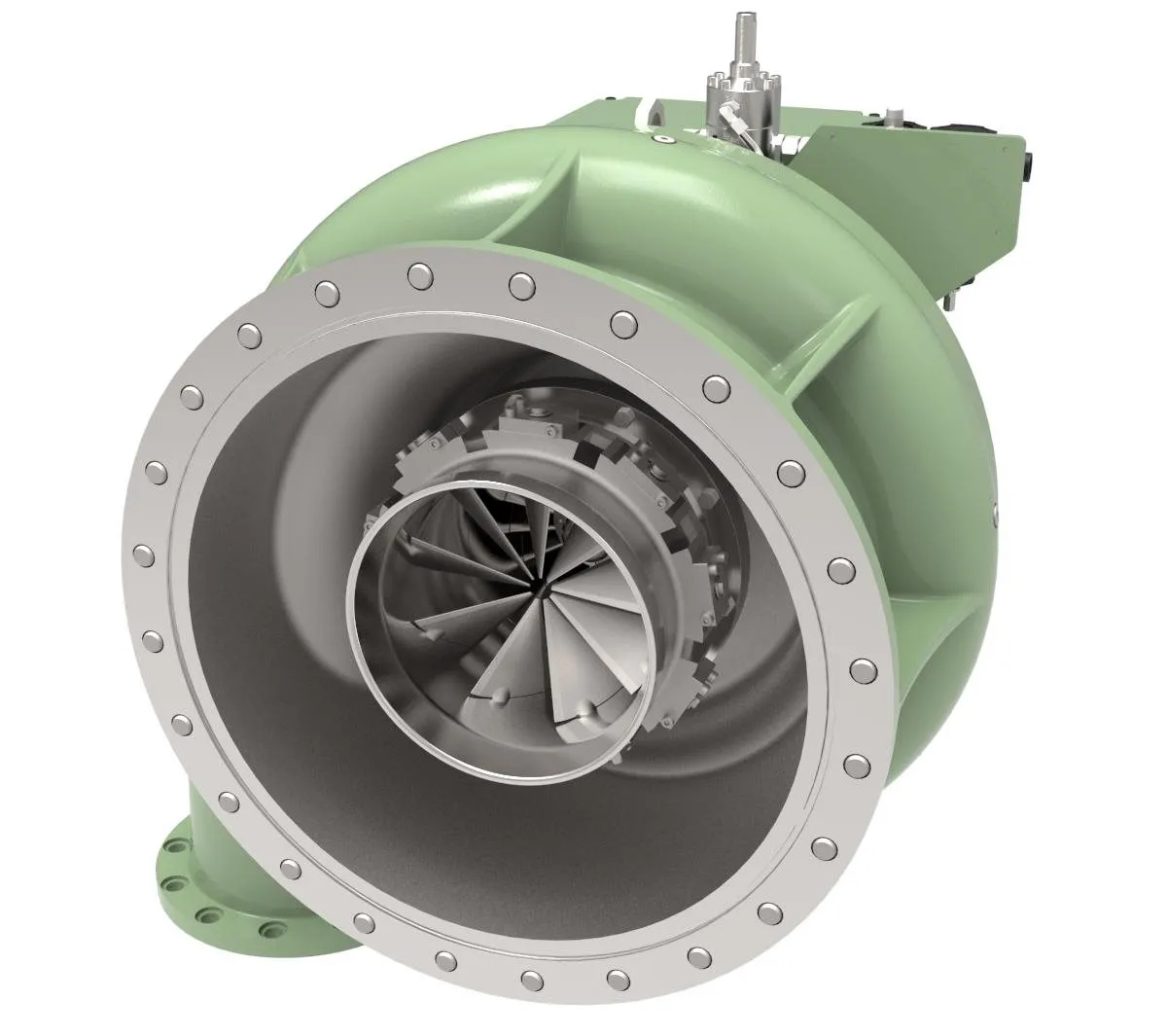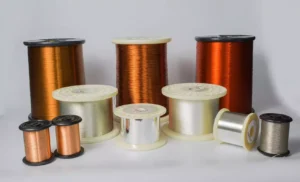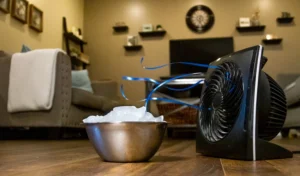A centrifugal blower is a powerful machine that moves air using a spinning impeller.
This impeller creates centrifugal force, pulling air in and pushing it out.
It’s a key tool for moving air in many different settings.
Ready to dive deep into the world of centrifugal blowers?
We’ll explore what they are, how they work, their different types, and why they’re so important in various industries.
Let’s get started and uncover the secrets behind these essential devices.
What is a Centrifugal Blower?
A centrifugal blower is a machine that moves air or other gases.
It uses a spinning part called an impeller.
This impeller takes in air and then pushes it out using a force called centrifugal force.
It’s like a fan but designed for stronger air movement.
Centrifugal blowers are simple yet powerful.
They have three main parts: the impeller, the housing, and the drive.
The impeller has blades that spin very fast.
This spinning pulls air in and then throws it out.
The housing is like a shell that guides the air.
The drive is what makes the impeller spin, either directly or with a belt.
Because they are so good at moving air, you find them in many places.
Think about drying things or moving air in buildings.
They are very useful.
How the Impeller Works
The impeller is the heart of the blower.
Its blades are key to how well the blower moves air.
There are different blade shapes: forward curved, backward curved, and radial.
Each shape changes how the air moves and how much pressure it builds.
The right blade shape means the blower works best for its job.
For example, some blades are better for moving a lot of air at low pressure.
Others are better for moving less air but at high pressure.
This choice affects how much energy the blower uses and how much noise it makes.
The Role of the Housing
The housing is more than just a cover.
It helps direct the air after the impeller throws it out.
It’s often shaped like a spiral, called a volute.
This shape helps turn the fast-moving air into useful pressure.
A good housing design makes sure the air flows smoothly.
This means less energy is wasted and the blower works better.
The material of the housing also matters.
It needs to be strong enough for the job.
For example, if the air is hot or has harsh chemicals, the housing needs to be made of special materials like stainless steel.
Drive Mechanisms: Direct vs. Belt
The drive mechanism is how the motor connects to the impeller.
There are two main types: direct drive and belt drive.
In a direct drive, the motor is hooked right to the impeller.
This makes it very efficient and responsive.
It’s good for jobs where you need exact control over speed.
It also needs less upkeep because there are no belts to worry about.
Belt drives use a belt to connect the motor and impeller.
This lets you change the speed more easily.
It’s good for jobs where you need to adjust the airflow often.
Belt drives can also handle different impeller sizes.
This makes them flexible for many uses.
Both types have their own benefits, depending on what the blower needs to do.
| Feature | Direct Drive | Belt Drive |
| Efficiency | Higher, less energy loss | Lower, some energy loss through belt |
| Maintenance | Lower, no belts to replace | Higher, belts need checking and replacement |
| Speed Control | Precise, motor speed directly controls | Flexible, can adjust speed with pulley sizes |
| Cost | Often higher initial cost | Often lower initial cost |
| Applications | Exact speed control, continuous operation | Variable airflow, different impeller sizes |
This table shows a quick look at the main differences.
Choosing between them depends on your specific needs.
Do you need super precise control?
Or do you need more flexibility?
These questions help decide the best drive type for your blower.
Understanding these parts helps you see why centrifugal blowers are so important.
They are not just simple fans.
They are engineered machines that do a big job in many industries.
What are the different types of centrifugal blowers?
Confused by all the different blower names?
Wondering which one is right for your needs?
Let’s clear up the confusion and explore the main types of centrifugal blowers.
Centrifugal blowers come in many forms, each designed for specific jobs.
Their main differences are in the shape of their impeller blades.
These blade shapes change how the blower works, affecting its pressure, speed, and how well it moves air.
When we talk about centrifugal blowers, we often hear the words ‘fan’ and ‘blower’ used together.
But ‘blower’ usually means a stronger device.
It pushes air out in a circle, not in a straight line like a regular fan.
This makes blowers good for tough jobs.
The key thing that makes them different is the shape of their impeller blades.
These blades can be backward curved, forward curved, or radial.
Each type is made for certain air volumes and pressures.
They are used in many places, like cleaning air, moving dust, or moving materials through pipes.
They are good at building up air pressure, which is important for things like paint booths or drying processes.
Forward Curved Centrifugal Blowers
Forward curved blowers have blades that bend in the same direction the impeller spins.
They are good at making high pressure and moving a lot of air.
But they are not as energy efficient as other types.
You often see them in homes, like in furnaces, or in small air systems.
They are quiet and small, which makes them good for inside use.
Their design has an impeller, a shaft, bearings, and a housing that guides the air.
Even though they use more power, they are chosen when noise and size are more important.
Backward Inclined Centrifugal Blowers
Backward inclined blowers have blades that lean away from the spin direction.
They are more energy efficient, quieter, and use less power than forward curved types.
They are used a lot in factories for things like taking out bad air or collecting dust.
They work well with medium to high air pressure.
Their strong build helps them work well even when air flow changes.
Some have special blades, like curved single thickness or airfoil, for even better performance.
Curved single thickness blades are strong and good for air with small dirt bits.
Airfoil blades are shaped like airplane wings.
They are best for moving a lot of clean air quietly, like in offices or labs.
They save energy and make less noise.
| Blade Type | Description | Common Use Cases |
| Forward Curved | Blades curve in direction of rotation; high static pressure, high CFM. | Residential HVAC, small air handlers, cleanroom recirculation. |
| Backward Inclined | Blades tilt away from rotation; high efficiency, lower noise, less energy. | Industrial exhaust, process ventilation, dust collection. |
| Radial | Blades extend straight out; rugged, good for dirty air. | Industrial dust collection, pneumatic conveying, grain handling. |
Export to Sheets
Radial Centrifugal Blowers
Radial blowers have blades that stick straight out from the center.
This simple design means dirt and dust do not build up easily.
They are very strong and good for moving dusty or dirty air.
You find them in places that collect dust, move materials, or handle grain.
They can make medium to high pressure and move a lot of air.
They are also easy to clean.
This makes them very useful in places like woodworking shops or concrete factories.
Some models have extra strong sides for even tougher jobs.
Airfoil Centrifugal Blowers
Airfoil blowers are made for top energy saving and quiet work.
Their blades are shaped like airplane wings.
This helps air move smoothly and quietly.
They are used in places where clean air and low noise are very important.
Think hospitals, cleanrooms, or data centers.
They move a lot of clean air using less power.
They can also change speed easily.
This helps save energy and makes them last longer.
They are a good choice for buildings that want to be energy efficient.
Radial Tip Centrifugal Blowers
Radial tip blowers mix the strength of radial blowers with the efficiency of backward inclined ones.
Their blades have special tips.
This helps them handle many types of air flow and pressure.
They are good for air that is dirty or has moisture.
You use them for moving materials, drying grain, or moving hot gases.
They are often made of strong materials like stainless steel.
They also have special coatings to last a long time.
This makes them very tough for hard industrial jobs.
Inline Centrifugal Blowers
Inline blowers combine the strong pressure of centrifugal blowers with the small size of axial fans.
They fit into round or square ducts.
They use backward inclined impellers to move air for both supply and exhaust.
You can put them in any direction: flat, up, or at an angle.
This makes them good for small spaces, like in ceilings or for upgrading air systems.
They cost less to put in and save space.
They are used in commercial buildings for boosting air or in labs.
They work well and are quiet.
They can also work with smart controls for complex air systems.
Plug Centrifugal Blowers
Plug blowers are different because they do not have a full housing.
They are open.
This lets them go right into big air spaces or hot areas.
Like in ovens or dust collection systems.
They can move a lot of air even when it is very hot.
You also use them in special heaters.
When you choose a plug blower, you need to know how much air you need, the pressure, the temperature, and how dense the air is.
This helps make sure the blower works safely and well in tough, hot, or dirty places.
Volute Centrifugal Blowers
Volute blowers have a special spiral-shaped casing.
This shape helps guide the air and turn its speed into pressure.
The spiral gets bigger as it goes around.
This stops air from losing speed and getting messy.
Volute blowers are important for air systems that need exact air control and steady pressure.
Like for burning fuel, keeping cleanrooms pressurized, or balancing air in buildings.
Some have a single spiral, others have a double spiral.
A double spiral helps balance the blower better.
This makes it last longer for jobs that run all the time.
Knowing about the spiral shape helps make the blower work best and save energy.
Multistage Centrifugal Blowers
Multistage blowers use many impellers in a row.
This helps them build up air pressure step by step.
They are good for jobs that need very high pressure and a lot of air.
Like cleaning water, moving materials through pipes, or moving air in mines.
They save energy because they spread the pressure work over many steps.
Each step makes the air pressure higher.
They keep the air flow steady.
They can be made with different impeller types.
They can also have smart controls and ways to check for problems.
This makes them strong and long-lasting for tough jobs.
How Centrifugal Blowers Work?
Ever wondered about the magic behind moving large amounts of air?
It’s not magic, it’s engineering!
Let’s explore the simple yet effective way centrifugal blowers do their job.
Centrifugal blowers are popular because they are simple, strong, and reliable.
They are built to work well in many tough places.
This makes them key for moving air, handling air, and collecting dust.
Their simple build also means they last long and are easy to take care of.
This is why they are used so much.
A typical centrifugal blower has a strong electric motor, a fan wheel (also called an impeller), and a tough outer case.
The fan wheel spins very fast.
As it spins, it pulls in air.
This air can sometimes have dust or fumes in it.
The spinning wheel then pushes this air out with force through an exit.
You can control how fast and in what direction this air goes.
This makes these blowers great for air systems, cleaning air, and moving materials.
They are often picked over other fans because they can move air better and faster at higher pressures.
They can handle many different air amounts and pressure needs.
They are also quieter and shake less than other air movers.
This makes them good for many jobs.
The Electric Motor: The Powerhouse
The electric motor is a very important part.
It makes the impeller spin.
This spinning creates a strong flow of air.
This air then gets pushed out at a right angle to where it came in.
There are two ways the motor can connect to the impeller: direct drive or belt drive.
Each way changes how well the blower works and what it can be used for.
In a direct drive system, the motor shaft is directly connected to the impeller.
This means power goes straight from the motor to the impeller.
It gives strong power and quick response.
You can control the blower’s speed very precisely by changing the motor’s speed.
This system does not need belts or chains.
So, it needs less fixing, uses less energy, and is less likely to break down.
This makes it perfect for jobs that run all the time.
Direct drive blowers can be for high pressure or low pressure.
High-pressure ones are used for burning fuel or moving materials with air.
Low-pressure ones are for cooling air, general air flow, or taking out bad air in buildings.
Belt-driven motors, also called indirect drives, use a belt to connect the motor to the impeller.
The belt lets you change the speed.
This means you can fine-tune the air flow for different needs.
This type of blower is good for medium to low pressure jobs.
It is especially good when you want to save energy by changing the speed.
The belt helps lower the force needed from the motor.
This saves money on fixing and makes the motor last longer.
Belt-driven blowers can also use different impeller sizes.
This makes them very flexible for changing air flow and pressure needs.
The Fan Wheel (Impeller): The Air Mover
The speed of the fan wheel depends on the motor and how it is used.
The fan wheel, or impeller, is key to how well the blower works.
It gives speed to the air flow.
It also creates the needed air pressure.
It holds the blades and decides what type of blower it is: backward curved, forward curved, or radial.
Centrifugal fan wheels are usually round with straight slots.
These blades can be straight, angled, or curved.
Each shape changes how the air flows and how much energy is used.
The blade type affects noise, pressure, air flow, and energy use.
Air leaves the impeller at the blade tips.
It then goes into the blower case.
Choosing the right fan depends a lot on the fan wheel type.
This also affects what the blower is used for, its pressure needs, and how noisy it is.
The material of the fan wheel is also important.
It can be steel, aluminum, or special metals.
This choice depends on the air it moves.
For example, if the air has harsh chemicals, is very hot, or can explode, special materials are needed.
| Impeller Design | Characteristics | Typical Uses |
| Backward Curved | Energy efficient, low noise. | HVAC systems. |
| Forward Curved | High volume, low pressure. | Ventilation fans, air handling units. |
| Radial Bladed | Handles dirty air, strong. | Material handling, dust collection. |
Export to Sheets
The Impeller Housing: Guiding the Air
The housing, or casing, of a centrifugal blower guides the air flow.
It also helps make sure there is not too much shaking or noise.
The materials for the housing are chosen based on where it will be used.
For tough places, strong materials are needed.
Common choices are stainless steel, galvanized steel, aluminum, and special mixes.
Stainless steel is often picked for factories because it is strong, does not rust easily, and is simple to clean.
The housing shape also affects how the air leaves the blower.
To make air flow smooth, the parts are carefully put together.
A well-made housing saves energy, stops leaks, and keeps the air pressure steady.
The housing has a spiral shape.
This shape helps speed up the air as it moves to the exit.
This makes the pressure and air volume as high as possible.
This design changes the air direction twice before it goes into the ducts.
For extra protection, housings can have special coatings.
These coatings help against harsh conditions, chemicals, and rust.
This makes them last longer.
Blower Airflow: The Core Function
The main job of a centrifugal blower is to move air.
It is different from other fans.
A centrifugal blower pulls air, liquid, gas, or small bits of material into its opening.
This makes it good for collecting dust, taking out fumes, moving materials with air, and supplying air for burning.
The spinning blades push the air out through the exit.
The air moves out in a circle, not straight.
This makes a steady, high-pressure air flow.
This is good for many air moving jobs.
The spinning blades create a low-pressure area in the middle.
This pulls air in.
As the impeller spins, the air is pushed out to the blade tips.
This makes a high-pressure area.
This fast-moving energy then turns into steady pressure as the air is caught and guided by the spiral housing.
The low-pressure area in the middle keeps pulling air in.
This makes a strong and steady flow.
This air then moves from the low-pressure area to the high-pressure area.
It goes around the impeller and then smoothly leaves the housing.
This way of working helps the blower handle different air system needs.
It makes it reliable for changing factory loads, moving air in buildings, or big air systems.
This is why centrifugal blowers are key for moving air, cleaning air, moving materials, and other factory jobs where exact, high-pressure air flow is needed.
What are some common uses for centrifugal blowers?
Ever wondered where these powerful air movers actually get used?
From keeping factories clean to moving materials, centrifugal blowers are everywhere.
Let’s look at their many uses.
Centrifugal blowers are used in many places where you need to move air all the time.
They are good for jobs that need a steady and strong air flow.
This includes moving materials through pipes.
They can be changed to fit many different factory needs.
Centrifugal blowers are very important in many industries.
They help keep air moving and clean.
This is important for workers to be safe and comfortable.
They are used in places where air needs to be moved or cleaned.
These blowers come in different types, like backward curved, backward inclined, and radial.
Each type is good for a specific job.
For example, some are made to handle clean air.
Others are made for air with dust or small bits in it.
They are key for taking out bad air and bringing in fresh air.
Clean Air Handling
Moving clean air is a big job for these blowers.
In factories, it is important to have good air.
This means taking out bad fumes and bringing in fresh air.
Centrifugal blowers help with this.
They are made to handle clean, dry air or air with only a little bit of dust.
These strong blowers are needed to make sure old air is replaced with new air.
This keeps the air healthy for people working there.
Dust Loading and Collection
Dust is a big problem in many places.
Centrifugal fans and blowers help clean the air by collecting dust.
They are part of a dust collection system.
This system helps make the air safe to breathe.
These blowers pull in air with dust.
Then, they move it through a system that cleans the air.
They can be put into hood systems that catch dust from work areas.
Or they can be the main part of air cleaning systems, like big filters or ducts.
They help keep the air clean and safe.
Pneumatic Material Handling
Moving materials with air is called pneumatic material handling.
Centrifugal blowers are very important for this.
They help keep the air pressure steady.
This stops things from getting stuck or falling out of the pipes.
These systems can move many things, like sand, small plastic bits, wood chips, and even coal.
A pneumatic system uses feeders, fans, blowers, pipes, and filters.
When picking a blower for this, you need to think about how heavy the material is.
This helps choose the right blade type, how it is driven, and any other parts needed for it to work best.
Saturated Air Handling
Saturated air is air that has a lot of moisture or gas in it.
This air is usually heavier because of the water or gas.
So, it needs a stronger centrifugal blower.
Because of the moisture, the blower needs to be made of stainless steel.
It also needs a special coating, like epoxy.
The main problem with wet air is that it can make the blower rust.
To stop this, blowers for wet air are made from materials that do not rust easily.
They also have coatings to protect them.
A well-made system helps save money on repairs and makes the blower last longer.
High-Temperature Applications
Some jobs need very hot air.
Like in heat treatments, ovens, or furnaces.
These use hot air to move heat around.
Centrifugal blowers for these jobs must be very strong and last a long time.
They need to handle high heat.
Even with good design, these blowers can wear out because of the heat.
So, it is important to check and fix them often.
This stops big problems.
For very hot places, special open-type blowers are used.
These can move a lot of air at low pressure.
They come in different wheel types and materials to fit different needs.
Dairy Processing
In dairy factories, centrifugal blowers move and reuse air.
These blowers must follow rules for food processing tools.
They help move air and clean it.
They are also used to dry things like cheese and other dairy products.
They help make sure the air is clean and safe for food production.
Incinerator Waste Disposal
Incinerators burn waste.
Centrifugal blowers are made for these systems.
They handle the gas volume and pressure needed.
A high-pressure blower pushes air into the incinerator.
Another blower pulls out the exhaust gas.
For special furnaces that burn sludge, a multi-stage blower system is used.
This gives the high pressure needed for enough air.
These blowers are made to handle bad effects from sludge or gases.
Rules for blowers in incinerators are strict.
They keep changing as people care more about the environment.
Makers of blowers follow these rules to make sure the air is clean.
What are the benefits of using centrifugal blowers?
Thinking about using a centrifugal blower?
Wondering if it’s the right choice for you?
Let’s look at the big advantages of these powerful machines.
Centrifugal blowers are a great way to move a lot of air at high pressure.
They are also easy to take care of.
Keeping air moving in factories is very important for worker safety.
This is even more important now that we care more about the environment.
When people design buildings and factories, they often plan to use centrifugal blowers from the start.
This is because they are known to be very reliable.
These blowers can be changed to fit the exact needs of a job.
This makes them a top choice for many factory uses.
They are built to be strong and last a long time.
This means they can handle tough jobs without breaking down.
They are also made to be safe.
This is very important in places where there are risks.
For example, they can be made to handle air that can explode.
This helps keep workers safe.
They are also good at keeping a steady flow of air.
This is important for many processes that need exact conditions.
All these things make centrifugal blowers a smart choice for many different needs.
Low Maintenance
One of the best things about centrifugal blowers is that they do not cost much to take care of.
After you spend money to buy and put them in, you do not have to spend much to keep them running.
This helps keep overall costs down.
Other air systems often need to be checked for dust and dirt.
But centrifugal blowers are easier to care for.
Usually, you just need to vacuum the motor and vents.
This is enough to keep them working well.
Their simple design makes them easy to fix and service.
This makes them a good choice for long-term use.
This saves time and money.
It also means less downtime for your work.
Energy Savings
Being efficient is very important for any factory tool.
It affects both cost and how much work gets done.
Centrifugal blowers are made to give a steady and strong air flow.
They can be up to 84% efficient.
This high level of efficiency is key for making big air flow systems work their best.
This means they use less electricity to do their job.
This saves money on energy bills.
It is also better for the environment.
Because they are so efficient, they can help businesses meet their energy-saving goals.
This makes them a smart choice for any company that wants to be more green.
Versatility and Adaptability
Centrifugal blowers are liked in many industries because they can be used for many different things.
They can be changed to fit the special needs of different factory jobs.
This makes them good for places that are always changing.
These blowers are a key part of many industries.
From making paper to building cars.
Each one is made to work its best and meet the special needs of the job.
They can handle different types of air, from clean to dirty.
They can also work in different temperatures and pressures.
This makes them very flexible.
You can find a centrifugal blower for almost any air-moving need.
Durability and Hazard Resistance
Today’s factories can be tough places for tools.
Equipment needs to be strong enough to handle hard conditions.
Centrifugal blowers are made to work well in places that are rusty, toxic, very hot, or very wet.
Each type of centrifugal blower is carefully made to handle these tough conditions.
And they still do a great job.
They are built with strong materials.
They can also have special coatings to protect them.
This makes them last a long time, even in the hardest jobs.
This means you do not have to replace them often.
This saves money and makes your work more reliable.
Conclusion
Centrifugal blowers are key for moving air in many ways.
They use a spinning part to push air out.
They are strong, efficient, and can be used for many jobs.
Understanding them helps you pick the right one for your needs.
FAQ
What is the main difference between a centrifugal fan and a centrifugal blower?
While often used interchangeably, a centrifugal blower typically creates higher pressure than a fan.
Blowers are designed for more demanding applications where higher pressure ratios are needed to move air effectively.
What are the primary types of centrifugal blower impellers?
The main types are forward curved, backward curved, and radial.
Each design offers different performance characteristics in terms of airflow, pressure, and efficiency, suiting various industrial needs.
How does a centrifugal blower create airflow?
An impeller spins rapidly, drawing air into its center.
Centrifugal force then pushes the air outward, increasing its velocity and pressure before it exits the blower through the housing.
What are the key benefits of using centrifugal blowers?
Centrifugal blowers offer high efficiency, low maintenance, and great versatility.
They are also very durable and can resist harsh conditions, making them ideal for tough industrial environments.
Can centrifugal blowers handle dirty or dusty air?
Yes, certain types like radial blowers are specifically designed for air streams with particulates.
Their simple blade design prevents clogging, making them reliable for dust collection and material handling.
Why is proper sealing important for a centrifugal fan housing?
Proper sealing prevents air leaks, which can reduce efficiency and waste energy.
It also helps maintain consistent static pressure, ensuring the blower performs as expected in the system.
What is the difference between direct drive and belt drive blowers?
Direct drive blowers connect the motor directly to the impeller for high efficiency and precise control.
Belt drive blowers use a belt, offering more flexibility in speed adjustment and impeller size options.
Are centrifugal blowers noisy?
Centrifugal blowers are generally quieter than some other fan types, especially those with airfoil blades.
Their design helps minimize turbulence and acoustic noise, making them suitable for noise-sensitive areas.







